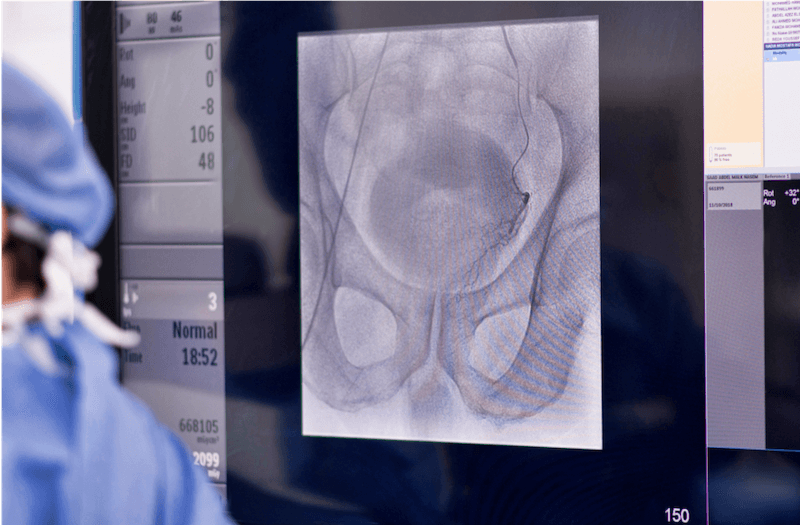Prostate Artery Embolization (PAE) in Los Angeles

Get relief from benign prostatic hyperplasia with prostate artery embolization (PAE) in Los Angeles. At ProVascularMD, we provide prostate artery embolization to help you overcome the life-limiting urinary symptoms of benign prostatic hyperplasia. Read this quick overview from our prostate specialists to learn more about prostate artery embolization, how it works, and what to expect when you undergo treatment. If you have any further questions about prostate artery embolization or benign prostatic hyperplasia, get in touch with us at ProVascularMD in Los Angeles or our other Southern California locations. We look forward to hearing from you.

Prostate Specialist
Dr. Michael Lalezarian
What is Prostate Artery Embolization?
Prostate artery embolization is a minimally invasive treatment for symptomatic benign prostatic hyperplasia (BPH). PAE can help relieve lower urinary tract symptoms, including urinary incontinence, irritative voiding symptoms, increased urinary frequency, urgency, and painful urination.
The procedure is performed by a vascular and interventional radiologist, usually in collaboration with your urologist. The prostate artery embolization procedure works by embolizing (blocking) the blood vessels that supply the prostate. This is accomplished by threading a catheter to the prostate artery through a tiny puncture in your arm or in your leg using real-time imaging. Once in position, microscopic beads are injected through the catheter into the prostate artery, blocking blood flow to the prostate. Following the procedure, the prostate shrinks, relieving BPH symptoms [1].

Who is Prostate Artery Embolization For?
Prostate artery embolization is used to treat symptoms of benign prostatic hyperplasia (BPH). BPH is a noncancerous condition in which the prostate gland becomes enlarged. Benign prostatic hyperplasia becomes more prevalent as men age, affecting roughly 50% of men by age 60, and roughly 80% of men older than 70 [1].
When enlarged, the prostate can obstruct the bladder and the urinary tract, causing lower urinary tract symptoms. Prostate artery embolization is only appropriate for men with symptoms of BPH. If you have urinary tract symptoms, such as frequent urination or inability to empty your bladder, then you may be a candidate for PAE. Eligibility for the PAE procedure is typically determined by urinalysis, a rectal exam, a prostate-specific antigen (PSA) test to rule out cancer, and/or an MRI or ultrasound of the prostate gland. To be considered as a candidate for PAE, typically you will need to have tried BPH medication for 6 months, and you may need to be screened for prostate cancer [1].
There are many other specialized interventions that are available for BPH, including Rezum water vapor therapy, GreenLight laser therapy, TURP resection therapy, UroLift implants, and the HoLEP procedure [2]. These therapies are beyond the scope of this article, but we encourage readers to thoroughly investigate their options before choosing a BPH treatment. Success rates, post-procedural recovery and potential side effects are particularly important to consider when comparing BPH treatments.
Patients often choose prostate artery embolization because it is less invasive than traditional surgery and less traumatic than other specialized interventions that target the prostate directly. Compared to other therapies, PAE provides minimal risk of sexual side effects, low risk of urinary incontinence, no hospital stay, quick recovery, and minimal downtime following the procedure [1].
How Successful is Prostate Artery Embolization?
Of the men who undergo prostate artery embolization, roughly 75%-80% report satisfactory symptom improvement. Current data indicates that prostate artery embolization lasts for 3-4 years [1], but prostate artery embolization is a relatively new procedure, and this data has been questioned for being representative of early, disparate procedure techniques [3]. Efforts have been made to optimize and standardize the procedure, which many operators believe has helped to increase its durability. Empirical data on this claim is pending.
Prostate Artery Embolization Procedure: What to Expect
Before the prostate artery embolization procedure, you will be given sedation and anti-anxiety medications to numb the area and help you relax. General anesthesia is typically not used for prostate artery embolization, so you will be awake during the procedure. You will be positioned flat on your back throughout, while your interventional radiologist administers the therapy.
Immediately after the prostate artery embolization procedure, you will be monitored for any complications until it is deemed safe for you to go home. Because prostate artery embolization is an outpatient procedure, you will go home on the same day as your procedure.
PAE results may not be immediate, as it takes time for the prostate to shrink. Some patients begin to experience relief within days of the procedure, but symptomatic changes are typically noticeable within 1-2 months. Symptoms continue to improve up to 6 months after the procedure.

Risks Of Prostate Artery Embolization
As with any medical intervention, there are risks of prostate artery embolization like certain complications and side effects. In general, prostate artery embolization is considered to be safe and effective.
The most drastic complication of prostate artery embolization is nontarget embolization, which describes the accidental injection of particles into arteries that supply the bladder or the rectum rather than the prostate. Nontarget embolization can cause tissue necrosis and organ damage. However, readers should know that imaging technology is now used to simulate injections before the actual injection takes place, allowing operators to ensure safe injections and minimize the risk of nontarget embolization [2].
When it comes to side effects, patients may experience a brief bout of urinary retention, blood in urine, blood in semen, or blood in stool. Post-PAE syndrome is another potential side effect, which can consist of urinary urgency, urinary frequency, dysuria, pressure in the pelvis, and/or pain in the pelvis. Puncture site bleeding or infection are also possible. In the vast majority of cases, these side effects are either self limiting (they resolve on their own), or they can be treated with medications [2].
Is Prostate Artery Embolization Right For Me?
Benign Prostatic Hyperplasia (BPH) Symptoms
Prostate Artery Embolization (PAE) Overview
Schedule Your Visit
Click the Chat Button
Vascular Care in Los Angeles
& San Bernardino County
Adelanto
Alhambra
Amboy
Angelus Oaks
Apple Valley
Arcadia
Azusa
Baker
Baldwin Park
Barstow
Bell Gardens
Big Bear City
Big Bear Lake
Bloomington
Blue Jay
Bryn Mawr
Burbank
Cedar Glen
Cedarpines Park
Chino
Chino Hills
Cima
Citrus
City of Industry
Claremont
Colton
Covina
Crestline
Daggett
Diamond Bar
Downey
Duarte
Eagle Rock
Earp
El Monte
Essex
Fawnskin
Fontana
Forest Falls
Fort Irwin
Glendale
Glendora
Grand Terrace
Green Valley Lake
Guasti
Hacienda Heights
Helendale
Hesperia
Highland
Highland Park
Hinkley
Irwindale
Joshua Tree
La Canada
La Crescenta
La Habra
La Mirada
La Puente
La Verne
Lake Arrowhead
Landers
Loma Linda
Lucerne Valley
Ludlow
Lytle Creek
Mentone
Monrovia
Montclair
Montebello
Monterey Park
Morongo Valley
Mountain Pass
Mt Baldy
Needles
Newberry Springs
Nipton
Norwalk
Ontario
Oro Grande
Parker Dam
Pasadena
Phelan
Pico Rivera
Pinon Hills
Pioneertown
Pomona
Rancho Cucamonga
Redlands
Rialto
Rimforest
Rosemead
Running Springs
San Bernardino
San Dimas
San Gabriel
Santa Fe Springs
Sierra Madre
Skyforest
South El Monte
South Pasadena
Sugarloaf
Temple City
Trona
Twentynine Palms
Twin Peaks
Upland
Victorville
Vidal
Walnut
West Covina
West San Dimas
Whittier
Wrightwood
Yermo
Yucaipa
Yucca Valley




